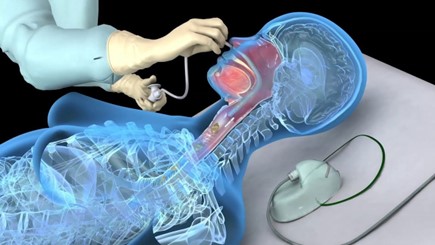The nurse provides care for a client diagnosed with pneumonia. The client is unable to expectorate respiratory secretions. The nurse suctions the client's nasopharyngeal airway. When is suctioning technique correct?
Advances catheter 2-3 inches (5 to 7.6 cm).
Applies suction intermittently for 20 seconds.
Moistens catheter prior to insertion.
Uses non-dominant hand to manipulate catheter.
The Correct Answer is C
When suctioning a client's nasopharyngeal airway, the nurse should moisten the catheter with sterile saline or water-soluble lubricant prior to insertion. This helps to decrease discomfort and trauma to the client's nasal mucosa.
Advancing the catheter 2-3 inches (5 to 7.6 cm) (a) is not correct because it can cause injury to the client's airway or trachea. The catheter should only be inserted to a distance equal to the distance from the nose to the earlobe (about 6 to 8 inches or 15 to 20 cm).
Applying suction intermittently for 20 seconds (b) is not correct because it can cause hypoxia and trauma to the client's airway. The suction should be applied continuously while withdrawing the catheter, for no more than 10 seconds.
Using the non-dominant hand to manipulate the catheter (d) is not correct because it can cause the catheter to become contaminated with the nurse's non-sterile hand. The dominant hand should be used to manipulate the catheter while maintaining sterile technique.

Nursing Test Bank
Naxlex Comprehensive Predictor Exams
Related Questions
Correct Answer is D
Explanation
After an incisional biopsy of a skin lesion, the client should be instructed to keep the suture area covered with gauze to protect it from irritation and infection. The area should be kept clean and dry, but cleansing with hydrogen peroxide is not necessary and may actually delay healing. The use of hydrocortisone cream is not recommended as it may interfere with wound healing. The area should not be left open to air as this may increase the risk of infection. The client should also be instructed to avoid strenuous activity and lifting heavy objects until the site has fully healed.

Correct Answer is B
Explanation
Dropping the needle cap on the floor contaminates it, and any attempt to clean it with alcohol will not make it sterile again. Therefore, the only way to ensure that the injection will be sterile is to use a new sterile syringe and needle.
Holding the syringe upright or cleansing the contaminated needle cap with alcohol is not enough to ensure sterility and can put the patient at risk for infection.

Whether you are a student looking to ace your exams or a practicing nurse seeking to enhance your expertise , our nursing education contents will empower you with the confidence and competence to make a difference in the lives of patients and become a respected leader in the healthcare field.
Visit Naxlex, invest in your future and unlock endless possibilities with our unparalleled nursing education contents today
Report Wrong Answer on the Current Question
Do you disagree with the answer? If yes, what is your expected answer? Explain.
Kindly be descriptive with the issue you are facing.
